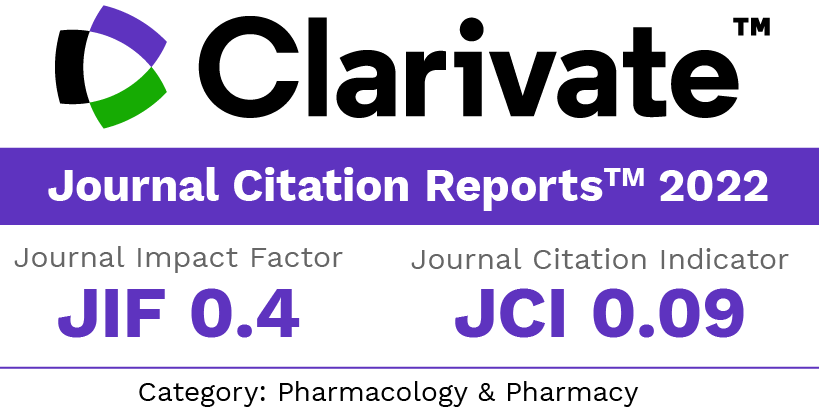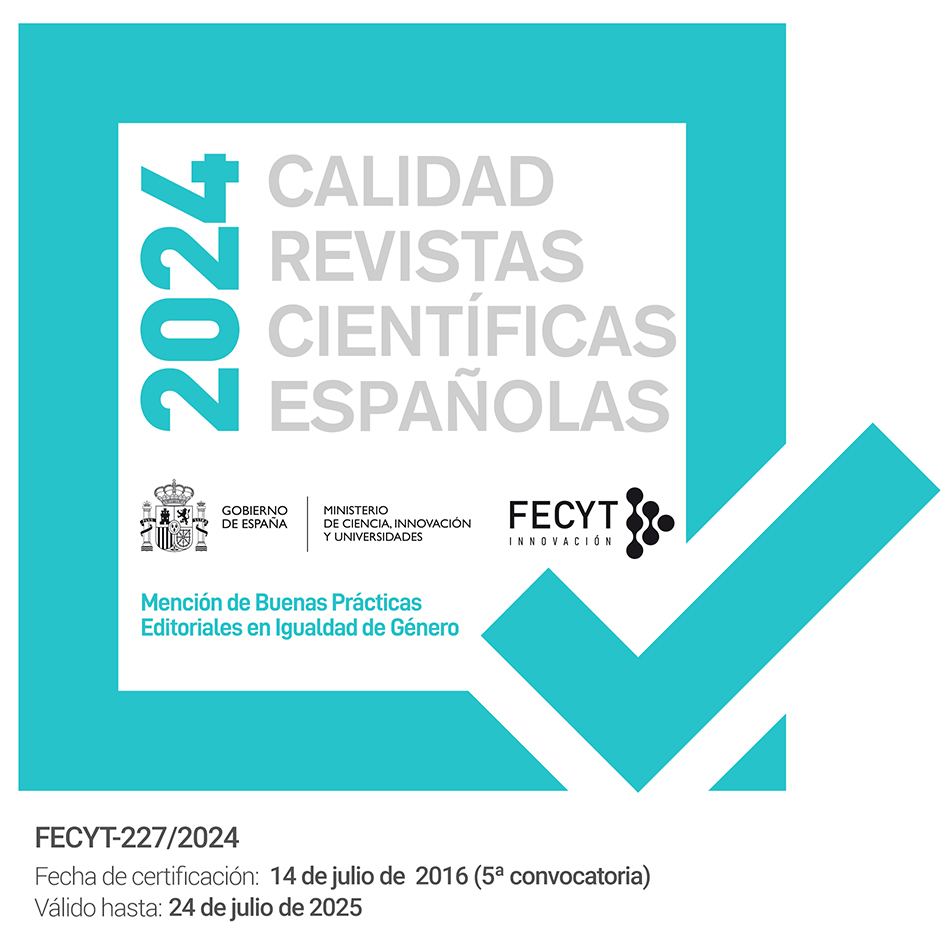Clinical and economic aspects of chondroitin sulfate in osteoarthritis management: a brief review of recent evidence
DOI:
https://doi.org/10.30827/ars.v63i3.24587Keywords:
osteoarthritis; chondroitin sulfate; outcome assessment; “pharmacoeconomics”Abstract
Introduction: Chondroitin sulfate was proposed as a more appropriate strategy for osteoarthritis long-term management than conventional treatment (nonsteroidal anti-inflammatory drugs and acetaminophen). However, its efficacy has been widely discussed and its public financing by the Spanish National Health System has been questioned. The aim of this paper was review on the clinical and economic aspects of chondroitin sulfate in osteoarthritis treatment.
Method: A bibliographic search of recent literature was carried out until March 9th, 2022. The databases used were MEDLINE and Scopus.
Results: According to the set of clinical studies identified in the search, chondroitin sulfate was effective in reducing cartilage volume loss, its clinical effects were estimated by objective (magnetic resonance or specific biomarkers) and subjective (visual analog pain scale or Lequesne index) outcome measures. In the set of studies reviewed, chondroitin sulfate proved to be an acceptable therapeutic option in clinical terms. Regarding economic aspects, only one study was identified, according to which, the prescription of chondroitin sulfate implies a lower cost per patient compared to non-steroidal anti-inflammatory drugs.
Conclusion: From the clinical and economic points of view, the findings of this brief review justify the presence of chondroitin sulfate in osteoarthritis guidelines.
Downloads
References
Sociedad Española de Reumatología. Prevalencia de Enfermedades Reumáticas en Población Española. Estudio EPISER [Internet]. 2016. Available from: https://www.ser.es/se-ha-presentado-el-estudio-episer-2016-en-la-sede-del-ministerio-de-sanidad-consumo-y-bienestar-social/
Bernad Pineda M. Situación actual de los SYSADOA en España. Reumatol Clin. 2016; 12(4):181–3. DOI: 10.1016/j.reuma.2016.03.012
Hochberg MC, Martel-Pelletier J, Monfort J, Möller I, Castillo JR, Arden N, et al. Combined chondroitin sulfate and glucosamine for painful knee osteoarthritis: a multicentre, randomised, double-blind, non-inferiority trial versus celecoxib. Ann Rheum Dis. 2016; 75(1):37–44. DOI: 10.1136/annrheumdis-2014-206792
Bruyère O, Honvo G, Veronese N, Arden NK, Branco J, Curtis EM, et al. An updated algorithm recommendation for the management of knee osteoarthritis from the European Society for Clinical and Economic Aspects of Osteoporosis, Osteoarthritis and Musculoskeletal Diseases (ESCEO). Semin Arthritis Rheum. 2019;49(3):337–50. DOI: 10.1016/j.semarthrit.2019.04.008
Safiri S, Kolahi A-A, Smith E, Hill C, Bettampadi D, Mansournia MA, et al. Global, regional and national burden of osteoarthritis 1990-2017: a systematic analysis of the Global Burden of Disease Study 2017. Ann Rheum Dis. 2020;79(6):819–28. DOI: 10.1136/annrheumdis-2019-216515
Reginster J-Y, Dudler J, Blicharski T, Pavelka K. Pharmaceutical-grade Chondroitin sulfate is as effective as celecoxib and superior to placebo in symptomatic knee osteoarthritis: the ChONdroitin versus CElecoxib versus Placebo Trial (CONCEPT). Ann Rheum Dis. 2017; 76(9):1537–43. DOI: 10.1136/annrheumdis-2016-210860
Singh JA, Noorbaloochi S, MacDonald R, Maxwell LJ. Chondroitin for osteoarthritis. Cochrane Database Syst Rev. 2015; 28(1):CD005614. DOI: 10.1002/14651858.CD005614.pub2
Rubio-Terrés C, Grupo del estudio VECTRA. [An economic evaluation of chondroitin sulfate and non-steroidal anti-inflammatory drugs for the treatment of osteoarthritis. Data from the VECTRA study]. Reumatol Clin. 2010; 6(4):187–95. DOI: 10.1016/j.reuma.2009.12.009
FICHA TECNICA CONDROSULF 400 mg CAPSULAS [Internet]. [cited 2020 Oct 17]. Available from: https://cima.aemps.es/cima/dochtml/ft/64547/FichaTecnica_64547.html
Monfort J, Pujol J, Contreras-Rodríguez O, Llorente-Onaindia J, López-Solà M, Blanco-Hinojo L, et al. Effects of chondroitin sulfate on brain response to painful stimulation in knee osteoarthritis patients. A randomized, double-blind, placebo-controlled functional magnetic resonance imaging study. Med Clin (Barc). 2017; 148(12):539–47. DOI: 10.1016/j.medcli.2016.12.036
Morita M, Yamada K, Date H, Hayakawa K, Sakurai H, Yamada H. Efficacy of Chondroitin Sulfate for Painful Knee Osteoarthritis: A One-Year, Randomized, Double-Blind, Multicenter Clinical Study in Japan. Biol Pharm Bull. 2018 1;41(2):163–71. DOI: 10.1248/bpb.b17-00556
Henrotin Y, Marty M, Mobasheri A. What is the current status of chondroitin sulfate and glucosamine for the treatment of knee osteoarthritis? Maturitas. 2014; 78(3):184–7. DOI: 10.1016/j.maturitas.2014.04.015
Hochberg M, Chevalier X, Henrotin Y, Hunter DJ, Uebelhart D. Symptom and structure modification in osteoarthritis with pharmaceutical-grade chondroitin sulfate: what’s the evidence? Curr Med Res Opin. 2013; 29(3):259–67. DOI: 10.1185/03007995.2012.753430
Pelletier J-P, Raynauld J-P, Beaulieu AD, Bessette L, Morin F, de Brum-Fernandes AJ, et al. Chondroitin sulfate efficacy versus celecoxib on knee osteoarthritis structural changes using magnetic resonance imaging: a 2-year multicentre exploratory study. Arthritis Res Ther. 2016 03;18(1):256. DOI: 10.1186/s13075-016-1149-0
Osakidetza. Tratamiento de la artrosis: información farmacoterapéutica [Internet]. Vitoria; 2018. ((26)1). Available from: https://www.osakidetza.euskadi.eus/contenidos/informacion/cevime_infac_2018/es_def/adjuntos/INFAC_Vol_26_N%201_es.pdf
Martel-Pelletier J, Raynauld J-P, Mineau F, Abram F, Paiement P, Delorme P, et al. Levels of serum biomarkers from a two-year multicentre trial are associated with treatment response on knee osteoarthritis cartilage loss as assessed by magnetic resonance imaging: an exploratory study. Arthritis Res Ther. 2017 20;19(1):169. DOI: 10.1186/s13075-017-1377-y
Raynauld J-P, Pelletier J-P, Delorme P, Dodin P, Abram F, Martel-Pelletier J. Bone curvature changes can predict the impact of treatment on cartilage volume loss in knee osteoarthritis: data from a 2-year clinical trial. Rheumatology (Oxford). 2017 01;56(6):989–98. DOI: 10.1093/rheumatology/kew504
European Medicines Agency. Guideline of clinical investigation of medical products used in the treatment of Osteoarthritis [Internet]. London: EMA; 2020 Jan [cited 2020 Nov 2]. Available from: https://www.ema.europa.eu/en/documents/scientific-guideline/guideline-clinical-investigation-medicinal-products-used-treatment-osteoarthritis_en.pdf
Lagnaoui R, Baumevielle M, Bégaud B, Pouyanne P, Maurice G, Depont F, et al. Less use of NSAIDs in long-term than in recent chondroitin sulphate users in osteoarthritis: a pharmacy-based observational study in France. Therapie. 2006; 61(4):341–6. DOI: 10.2515/therapie:2006063
Honvo G, Reginster J-Y, Rabenda V, Geerinck A, Mkinsi O, Charles A, et al. Safety of Symptomatic Slow-Acting Drugs for Osteoarthritis: Outcomes of a Systematic Review and Meta-Analysis. Drugs Aging. 2019;36(Suppl 1):65–99. DOI: 10.1007/s40266-019-00662-z
Wandel S, Jüni P, Tendal B, Nüesch E, Villiger PM, Welton NJ, et al. Effects of glucosamine, chondroitin, or placebo in patients with osteoarthritis of hip or knee: network meta-analysis. BMJ. 2010;16;341:c4675. DOI: 10.1136/bmj.c4675
Simental-Mendía M, Sánchez-García A, Vilchez-Cavazos F, Acosta-Olivo CA, Peña-Martínez VM, Simental-Mendía LE. Effect of glucosamine and chondroitin sulfate in symptomatic knee osteoarthritis: a systematic review and meta-analysis of randomized placebo-controlled trials. Rheumatol Int. 2018 ;38(8):1413–28. DOI: 10.1007/s00296-018-4077-2
Zhu X, Sang L, Wu D, Rong J, Jiang L. Effectiveness and safety of glucosamine and chondroitin for the treatment of osteoarthritis: a meta-analysis of randomized controlled trials. J Orthop Surg Res. 2018; 6;13(1):170. DOI: 10.1186/s13018-018-0871-5
Martel-Pelletier J, Farran A, Montell E, Vergés J, Pelletier J-P. Discrepancies in composition and biological effects of different formulations of chondroitin sulfate. Molecules. 2015; 20(3):4277–89. DOI: 10.3390/molecules20034277
Honvo G, Bruyère O, Reginster J-Y. Update on the role of pharmaceutical-grade chondroitin sulfate in the symptomatic management of knee osteoarthritis. Aging Clin Exp Res. 2019; 31(8):1163–7. DOI: 10.1007/s40520-019-01253-z
Volpi N. Chondroitin Sulfate Safety and Quality. Molecules. 2019 Apr ;24(8). DOI: 10.3390/molecules24081447
Wang Y, Zhang M, Huan Z, Shao S, Zhang X, Kong D, et al. FSH directly regulates chondrocyte dedifferentiation and cartilage development. J Endocrinol. 2021; 248(2):193–206. DOI: 10.1530/JOE-20-0390
Mobasheri A, Lambert C, Henrotin Y. Coll2-1 and Coll2-1NO2 as exemplars of collagen extracellular matrix turnover - biomarkers to facilitate the treatment of osteoarthritis? Expert Rev Mol Diagn. 2019; 19(9):803–12. DOI: 10.1080/14737159.2019.1646641
Barraquer A, Monge I, Álvarez A, de Antonio M, Peral O. ¿Conlleva la desprescripción de condroprotectores en pacientes con artrosis un incremento del consumo de analgésicos? Estudio observacional retrospectivo. Pharm Care Esp. 2022;24(1):7–19.
Monfort J, Martel-Pelletier J, Pelletier J-P. Chondroitin sulphate for symptomatic osteoarthritis: critical appraisal of meta-analyses. Curr Med Res Opin. 2008; 24(5):1303–8. DOI: 10.1185/030079908x297231
Aweid O, Haider Z, Saed A, Kalairajah Y. Treatment modalities for hip and knee osteoarthritis: A systematic review of safety. J Orthop Surg (Hong Kong). 2018; 26(3):2309499018808669. doi: 10.1177/2309499018808669.
Hochberg MC, Martel-Pelletier J, Monfort J, Möller I, Castillo JR, Arden N, et al. MOVES Investigation Group. Combined chondroitin sulfate and glucosamine for painful knee osteoarthritis: a multicentre, randomised, double-blind, non-inferiority trial versus celecoxib. Ann Rheum Dis. 2016; 75(1):37-44. doi: 10.1136/annrheumdis-2014-206792.
Published
How to Cite
Issue
Section
License
Copyright (c) 2022 Francisco Javier Ferreira Alfaya

This work is licensed under a Creative Commons Attribution-NonCommercial-ShareAlike 4.0 International License.
The articles, which are published in this journal, are subject to the following terms in relation to the rights of patrimonial or exploitation:
- The authors will keep their copyright and guarantee to the journal the right of first publication of their work, which will be distributed with a Creative Commons BY-NC-SA 4.0 license that allows third parties to reuse the work whenever its author, quote the original source and do not make commercial use of it.
b. The authors may adopt other non-exclusive licensing agreements for the distribution of the published version of the work (e.g., deposit it in an institutional telematic file or publish it in a monographic volume) provided that the original source of its publication is indicated.
c. Authors are allowed and advised to disseminate their work through the Internet (e.g. in institutional repositories or on their website) before and during the submission process, which can produce interesting exchanges and increase citations of the published work. (See The effect of open access).























